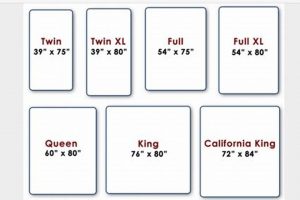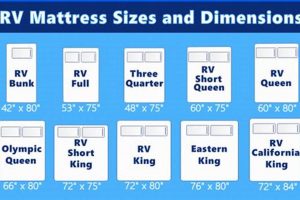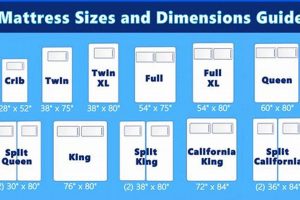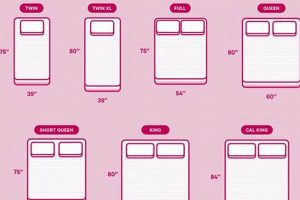A standard American queen mattress measures 60 inches in width and 80 inches in length. When converted to the metric system, these dimensions equate to approximately 152 centimeters wide and 203 centimeters long. These measurements define the sleeping surface area available on a queen mattress.
Understanding the precise dimensions of a mattress is crucial for several reasons. It ensures compatibility with bed frames, allows for accurate space planning within a bedroom, and aids in the selection of appropriate bedding. Historically, mattress sizes have evolved to accommodate the increasing height and width of individuals, leading to the development of the queen size as a popular option offering more space than a full-size mattress.
Therefore, when considering the purchase of a mattress, knowing the specific centimeter measurements facilitates seamless integration into existing bedroom layouts and guarantees comfort for sleepers.
Tips on Mattress Dimensions
The following are recommendations for ensuring accurate measurement and effective use of mattress dimensions expressed in the metric system.
Tip 1: Always Double-Check Conversions: When purchasing a mattress described in inches, verify the conversion to centimeters using a reliable calculator or conversion tool. This prevents errors in understanding the actual size.
Tip 2: Account for Frame Dimensions: Remember that the external dimensions of a bed frame may exceed the indicated size of the mattress it is intended to hold. Measure both the frame and the intended mattress to ensure compatibility.
Tip 3: Consider Room Size: Before purchasing, accurately measure the available space in the bedroom. A mattress may fit the frame but might overcrowd the room, hindering movement and functionality.
Tip 4: Check Mattress Depth: Mattress depth, also provided in centimeters, affects the type of sheets and bedding required. Account for this dimension to avoid purchasing ill-fitting linens.
Tip 5: Consult Manufacturer Specifications: Different manufacturers may have slight variations in dimensions. Always refer to the manufacturer’s specifications for the most precise measurements.
Tip 6: Measure After Delivery: Confirm the actual measurements of the mattress after delivery to ensure it matches the advertised specifications. This can help identify any discrepancies early on.
Tip 7: Use Centimeters for Accuracy: Centimeters provide a finer level of detail compared to inches. Utilize centimeter measurements when making critical decisions about mattress placement and bedding purchases.
Adhering to these tips ensures a well-informed mattress purchase, optimizing space utilization and comfort within the bedroom environment.
This information provides a solid foundation for making informed decisions regarding mattress selection and integration into living spaces.
1. Width
The dimension “Width: 152 cm” is a defining characteristic of the dimensional standards typically associated with a queen mattress. This measurement, equivalent to 60 inches, dictates the lateral space available on the mattress. A deviation from this standard immediately disqualifies the product from being accurately categorized as a queen. For example, a mattress measuring 140 cm in width would not be considered a standard queen, even if its length matched the customary 203 cm. The specified width directly influences sleeping comfort and the capacity to accommodate one or two individuals.
Consider a scenario where a couple consistently experiences restricted movement during sleep on a smaller, full-size mattress. Upgrading to a mattress with a 152 cm width provides each sleeper with approximately 76 cm of personal space. This increase alleviates crowding and contributes to improved sleep quality. Further, understanding this precise width is essential when selecting bed frames, as frames designed for queen mattresses are engineered to accommodate this specific dimension. Purchasing a frame intended for a full-size mattress, which typically measures around 137 cm in width, would result in an improper fit for a 152 cm wide mattress.
In summary, the 152 cm width is not merely a detail but a crucial component defining a queen size mattress. Its significance extends from ensuring adequate sleeping space to guaranteeing compatibility with corresponding frames and bedding. A comprehensive understanding of this dimension enables informed consumer decisions and facilitates optimal utilization of bedroom space.
2. Length
The dimension “Length: 203 cm” represents a crucial parameter defining a queen mattress. This measurement, approximately 80 inches, dictates the longitudinal space available to the sleeper. As a component of the specifications, a deviation from this length disqualifies the mattress from conforming to standard queen specifications. A mattress measuring, for instance, 190 cm in length, even if maintaining the standard 152 cm width, would not be categorized as a standard queen size. Consequently, the specified length directly impacts the sleeping posture and suitability for individuals of varying heights.
Consider an instance where an individual exceeding 183 cm (approximately 6 feet) consistently encounters discomfort due to their feet extending beyond the mattress’s edge. Transitioning to a queen with a 203 cm length provides adequate support for the entire body, facilitating improved sleep quality. Moreover, acknowledging this length is essential when selecting bed frames; frames designed for queen mattresses are fabricated to accommodate this specific dimension. Procuring a frame intended for a shorter, full-size mattress, which typically measures around 190 cm in length, would result in an incompatible fit for a 203 cm long mattress.
In summation, the 203 cm length is a critical determinant of a queen mattress. Its significance extends beyond mere dimensional specification, impacting user comfort, frame compatibility, and overall suitability. A comprehensive comprehension of this dimension allows for informed purchasing decisions and maximizes the utility of bedroom furnishings. Understanding the appropriate length mitigates the risk of selecting a mattress unsuitable for the intended user’s physical requirements.
3. Surface Area
The surface area of a mattress, directly derived from its linear dimensions, is a critical factor influencing sleep comfort and overall utility. For a queen mattress, the approximate surface area is calculated by multiplying its width (152 cm) by its length (203 cm), resulting in roughly 30,900 square centimeters. This area represents the total sleeping space available to the occupant. A smaller surface area, such as that of a full-size mattress, restricts movement and can lead to disrupted sleep, particularly for couples or individuals who prefer to stretch out.
Consider a scenario involving two adults sharing a sleeping space. A queen mattress, with its comparatively larger surface area, provides significantly more individual space compared to a smaller mattress. This additional area minimizes disturbances caused by one partner’s movements during sleep, leading to a more restful night for both. Furthermore, the surface area has practical implications beyond comfort. When selecting bedding, it is essential to ensure that sheets and blankets are appropriately sized to adequately cover the mattress without excessive overhang or insufficient coverage. Similarly, the available surface area dictates the type and quantity of pillows that can comfortably fit without overcrowding the bed.
In summary, the surface area of a queen mattress, determined by its centimeter dimensions, plays a vital role in determining sleep quality, compatibility with bedding, and the overall usability of the sleeping space. Understanding the relationship between dimensions and surface area empowers consumers to make informed purchasing decisions that align with their individual needs and preferences. Neglecting the surface area considerations when selecting a mattress could lead to discomfort, restricted movement, and compromised sleep quality. Accurate assessment of the surface area is, therefore, integral to optimizing the sleeping environment.
4. Bedroom Fit
The term “Bedroom Fit,” in the context of selecting a mattress, denotes the spatial compatibility between the mattress dimensions and the physical dimensions of the bedroom. The specified dimensions of a queen mattress, approximately 152 cm in width and 203 cm in length, directly influence the suitability of this mattress size for a given bedroom. An undersized room can lead to overcrowding, impeding movement and potentially affecting the room’s functionality. A room that is too small might require navigating around the bed, making furniture difficult to access, and generally creating an uncomfortable environment. The purchase of a queen mattress without prior consideration of its spatial implications frequently results in such undesirable outcomes. For instance, placing a queen mattress in a room measuring only 2.4 meters by 3 meters (approximately 8 feet by 10 feet) might leave insufficient space for essential furniture like nightstands or dressers and limit free movement.
Conversely, understanding the spatial requirements of a queen mattress allows for informed space planning. Prior to purchase, measuring the room’s dimensions and considering the placement of other furniture elements enables a prospective buyer to assess whether a queen mattress will fit comfortably within the space. This proactive assessment can prevent the purchase of a mattress that is ultimately unsuitable for the room. Furthermore, consideration of “Bedroom Fit” extends beyond the mere dimensions of the mattress. Factors such as door placement, window locations, and the presence of architectural features like built-in closets also influence the optimal mattress size. Accurately accounting for these factors contributes to a harmonious and functional bedroom design.
In summary, the concept of “Bedroom Fit” is intrinsically linked to the dimensions of a queen mattress. Neglecting to assess the spatial compatibility between the mattress and the bedroom can lead to overcrowding and functional limitations. Proactive space planning, incorporating accurate measurements and consideration of architectural features, is crucial for ensuring a comfortable and well-designed bedroom. A thorough understanding of these principles is essential for consumers seeking to optimize their living spaces.
5. Frame Compatibility
Frame compatibility is directly determined by dimensional adherence. The designated dimensions of a queen mattress, specifically its width of approximately 152 centimeters and length of approximately 203 centimeters, establish the foundational requirement for compatibility with bed frames. A bed frame intended for a queen-size mattress is engineered to precisely accommodate these measurements. Deviations from these dimensions, even minor ones, can result in an unstable and potentially unsafe sleeping platform. The incompatibility can manifest as a mattress that either overhangs the frame, creating a tripping hazard and compromising support, or is undersized, leading to excessive movement and potential damage to both the mattress and the frame. The consequences of neglecting proper frame compatibility extend beyond mere aesthetic concerns; they directly impact the structural integrity of the bed and the sleeper’s safety.
For instance, a common issue arises when individuals attempt to use a queen mattress with a frame designed for a full-size mattress, which typically measures around 137 cm in width. The resulting overhang not only looks visually unappealing but also places undue stress on the mattress edges, accelerating wear and tear. Conversely, using a frame that is slightly larger than the mattress can cause the mattress to shift and slide during sleep, potentially leading to disturbed rest and premature degradation of the mattress core. Furthermore, frame compatibility influences the effectiveness of support systems, such as slats or box springs. If the mattress is not properly supported due to an incompatible frame, it can lead to uneven weight distribution, sagging, and ultimately, a reduced lifespan of the mattress. This improper support affects sleep posture and can contribute to discomfort or even back pain.
In summary, frame compatibility, directly determined by adhering to the standard centimeter dimensions of a queen mattress, is a crucial factor ensuring stability, safety, and optimal performance of the sleeping system. Failure to consider frame compatibility can result in structural instability, accelerated wear and tear, compromised support, and potential safety hazards. Consequently, accurate measurement and adherence to dimensional standards are essential for achieving a harmonious and functional bed setup. Proper frame selection and usage extend the longevity of a mattress and optimize the overall quality of sleep.
6. Bedding Selection
The selection of appropriate bedding is intrinsically linked to the dimensions of a queen-size mattress. The linear measurements, in centimeters, dictate the necessary sizes and specifications for sheets, blankets, comforters, and other bedding accessories to ensure a proper fit and optimal functionality. Ignoring these dimensions can lead to ill-fitting bedding, discomfort, and reduced lifespan of both the bedding and the mattress itself.
- Sheet Dimensions
Fitted and flat sheets must correspond accurately with the mattress dimensions to ensure proper coverage and secure placement. Queen-size fitted sheets are designed for a width of approximately 152 cm and a length of 203 cm, accounting for mattress depth. Improperly sized sheets can slip off the corners, causing discomfort and requiring frequent readjustment. Flat sheets, also designed for queen mattresses, should have sufficient overhang to allow for proper tucking and a comfortable sleeping experience. If the dimensions do not match, it may cause an inadequate amount of material to be draped.
- Comforter and Blanket Size
Comforters and blankets provide warmth and insulation. The appropriate size is determined by the mattress dimensions plus allowances for drape. Queen-size comforters typically range from 218 cm to 229 cm in width and 229 cm to 244 cm in length. These dimensions ensure adequate coverage of the mattress and sufficient overhang on all sides. Under-sized comforters or blankets can leave portions of the mattress exposed, while excessively large ones may be cumbersome and difficult to manage.
- Pillow Arrangement and Size
Pillow selection is related to the width. Queen-size beds commonly accommodate two standard or queen-size pillows, or two king-size pillows for more width coverage. The dimensions of the pillows influence the overall aesthetic of the bed and the comfort of the sleeper. Standard pillows might appear proportionally small on a queen-size bed, whereas king-size pillows can create a more luxurious and balanced look. Selecting the right size can enhance the sleeping experience.
- Mattress Protector/Topper Fit
Mattress protectors and toppers are important for hygiene and comfort. They need to fit the mattress as closely as possible. Mattress protectors, like fitted sheets, come in Queen-size with width and length dimensions of about 152 cm and 203 cm respectively. Some mattress protectors have elastic skirts to ensure a secure fit over varying mattress depths. Using the correct size of mattress protector prevents slippage, protects the mattress from fluids and allergens, and contributes to a cleaner sleeping environment.
In conclusion, precise bedding selection is paramount for optimizing the utility and comfort. Adherence to the established dimensions of a queen mattress, when selecting sheets, comforters, and other bedding accessories, is essential for ensuring proper fit, enhancing aesthetic appeal, and prolonging the lifespan of both the bedding and the mattress itself. When bedding dimensions are selected without considering mattress centimeter dimensions, this may lead to financial loss, unusable bedding and an uncomfortable mattress.
7. Depth Consideration
Depth consideration, referring to the vertical dimension or thickness of a queen-size mattress, is integral to understanding its overall impact on comfort, aesthetics, and compatibility with various bedroom elements. While width and length, when expressed in centimeters, define the sleeping surface area, depth dictates support, ease of entry and egress, and visual proportionality within a room.
- Impact on Support and Comfort
Mattress depth influences the type and amount of materials that can be incorporated into its construction. Greater depth generally allows for more layering of comfort foams, support cores, and transition layers, leading to enhanced pressure relief and spinal alignment. For instance, a thinner mattress (e.g., 15 cm) may lack sufficient support for heavier individuals, while a deeper mattress (e.g., 30 cm) may provide optimal support and comfort for a wider range of body types and sleeping preferences. The depth needs to be considered as part of the formula with width and length.
- Compatibility with Bed Frames and Foundations
Mattress depth affects the overall height of the sleeping surface when combined with a bed frame and foundation. A shallow frame paired with a deep mattress can result in an excessively high bed, making it difficult to get in and out of. Conversely, a deep frame combined with a thin mattress can result in a low bed, potentially causing discomfort for individuals with mobility issues. Proper depth consideration ensures an ergonomic and accessible sleeping arrangement with the width and length in mind.
- Aesthetic Considerations
Mattress depth contributes to the visual profile of the bed within the bedroom. A disproportionately thin mattress on an ornate or high-profile frame can appear underwhelming, while an overly thick mattress on a minimalist frame may seem unbalanced. Selecting a mattress depth that complements the style and scale of the bed frame and surrounding furnishings is essential for creating a cohesive and aesthetically pleasing bedroom environment. Width and length affect the visual balance as well.
- Sheet Fit and Bedding Compatibility
Mattress depth influences the selection of appropriately sized sheets and bedding. Fitted sheets are designed to accommodate specific mattress depths, and using sheets that are too small can result in them slipping off the corners, while sheets that are too large may bunch up and create discomfort. Additionally, the depth of the mattress affects the overall dimensions required for comforters and blankets to ensure adequate coverage and drape. When it comes to bedding size, length and width are equally as important.
These considerations highlight the integral role of mattress depth in conjunction with its width and length in centimeters. Paying attention to these interdependencies allows for a more informed decision-making process, leading to improved sleep quality, optimized bedroom aesthetics, and enhanced compatibility with surrounding bedroom furniture and accessories. It is important to use width, length, and depth together in a formula to find what best fits a persons needs.
Frequently Asked Questions
The following section addresses common inquiries regarding the dimensions of queen mattresses, providing precise information for informed purchasing decisions.
Question 1: What are the exact centimeter measurements of a standard queen-size mattress?
A standard queen mattress measures approximately 152 centimeters in width and 203 centimeters in length.
Question 2: Do all queen mattresses adhere strictly to these centimeter dimensions?
While these dimensions are generally standard, slight variations of a centimeter or two may exist between manufacturers. Consulting product specifications is advisable.
Question 3: Why is understanding these centimeter measurements important?
Knowledge of these dimensions is crucial for ensuring compatibility with bed frames, accurate space planning in bedrooms, and selection of properly fitting bedding.
Question 4: How do these centimeter dimensions compare to those of other mattress sizes?
A queen mattress is wider and longer than a full-size mattress but narrower than a king-size mattress. Knowing the exact centimeter differences facilitates size comparisons.
Question 5: What considerations should be made for mattress depth, in centimeters, in addition to width and length?
Mattress depth impacts the overall height of the bed, the type of sheets required, and the level of support provided. This dimension should be factored into overall planning.
Question 6: Where can reliable conversion tools be found to convert inches to centimeters for mattress dimensions?
Online unit conversion websites and smartphone calculator applications provide accurate conversions between inches and centimeters.
The provided information offers a clear understanding of queen mattress dimensions, facilitating better decision-making during the purchase process. It is essential to use centimeter dimensions to guarantee bedroom layout fits your needs.
The next section delves into specific scenarios where accurate dimensional knowledge proves invaluable.
Queen Size Mattress in cm
This exploration of the “queen size mattress in cm” has underscored the critical importance of precise dimensional awareness. The 152 cm width and 203 cm length define the sleeping surface, influence bedroom fit, and dictate bedding compatibility. A thorough understanding of these measurements, along with depth considerations, is paramount for informed consumers.
Accurate dimensional knowledge ensures the selection of a mattress that optimizes comfort, enhances bedroom aesthetics, and provides lasting value. Neglecting to consider the “queen size mattress in cm” risks compromising sleep quality and overall satisfaction. Therefore, due diligence in confirming these measurements is strongly recommended for all prospective mattress purchasers.




![Best Queen Size Mattress with Boxspring [Deals!] Organic & Natural Mattress Buyer’s Guide: Non-Toxic Sleep Solutions Best Queen Size Mattress with Boxspring [Deals!] | Organic & Natural Mattress Buyer’s Guide: Non-Toxic Sleep Solutions](https://mattressworldpa.com/wp-content/uploads/2025/07/th-2253-300x200.jpg)
![Futon vs Reg Mattress Size: Are They The Same? [Guide] Organic & Natural Mattress Buyer’s Guide: Non-Toxic Sleep Solutions Futon vs Reg Mattress Size: Are They The Same? [Guide] | Organic & Natural Mattress Buyer’s Guide: Non-Toxic Sleep Solutions](https://mattressworldpa.com/wp-content/uploads/2025/07/th-2252-300x200.jpg)

